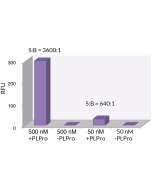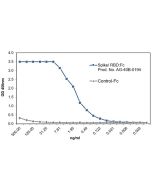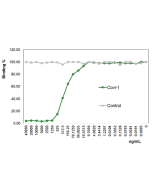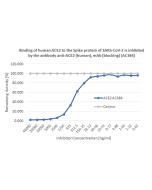Cookie Policy: This site uses cookies to improve your experience. You can find out more about our use of cookies in our Privacy Policy. By continuing to browse this site you agree to our use of cookies.
SouthBayBio
Mpro [3CLpro] (SARS-CoV-2) (rec.) (His)

| Product Details | |
|---|---|
| Synonyms | Chymotrypsin Like Protease; SARS Coronavirus Main Proteinase |
| Product Type | Protein |
| Properties | |
| Source/Host | E. coli |
| Sequence |
Mpro (Papain-like Protease) (aa 1540-1841) (Accession Nr. P0C6U8) is fused at the N-terminus to a His-tag. |
| Crossreactivity | Human |
| Application |
3CLpro recognizes the peptide sequence LQ[S/A/G] where it cleaves C-terminal to the amino acid glutamine. Working concentrations of this enzyme range from 10 to 100 nM using KTSAVLQ-Rh110 (SBB-PS0130) as substrate. |
| MW | ~36kDa |
| Purity | ≥98% (SDS-PAGE) |
| Concentration | Lot dependent. |
| Accession Number | P0C6U8 |
| Formulation | Liquid. In 50mM HEPES pH 7.5, 100mM NaCl, 1mM TCEP. |
| Other Product Data |
Click here for a Typical Lot-specific Product Datasheet from the Original Manufacturer |
| Declaration | Manufactured by South Bay Bio. |
| Shipping and Handling | |
| Shipping | DRY ICE |
| Short Term Storage | -80°C |
| Long Term Storage | -80°C |
| Handling Advice | Aliquot to avoid freeze/thaw cycles. |
| Use/Stability | Stable for at least 1 year after receipt when stored at -80°C. |
| Documents | |
| Product Specification Sheet | |
| Datasheet |
 Download PDF Download PDF |
3CLpro recognizes the peptide sequence LQ[S/A/G] where it cleaves c-terminal to the amino acid glutamine (use product SBB-PS0130, KTSAVLQ-Rh110-Glu as universal substrate). The protease 3CLpro is a potential drug target for coronavirus infections due to its essential role in processing the polyproteins that are translated from the viral RNA. The X-ray structures of the unliganded SARS-CoV-2 protease 3CLpro and its complex with an α-ketoamide inhibitor provides a basis for design of α-ketoamide inhibitors. This SARS Coronavirus recombinant 3CLpro is N-terminally His10-tagged and expressed in E.coli.












